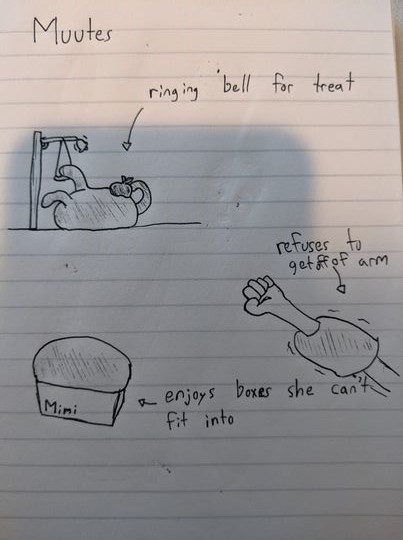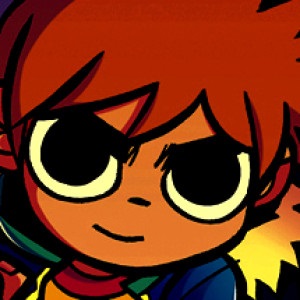
Muutes are domesticated creatures descended from the Mimics of old. They are loyal, durable, low-maintenance, and of a moderate animal intelligence. They digest food by enveloping it with their bodies. Their skin can imitate any texture or color and pattern. They respond well to dedicated training, and will incorporate materials such as steel plates or handles into their bodies. In general, the average Muute can learn around 20 shapes by name, and will mold itself into an appropriate shape upon command.
Muutes can be trained to assume specific shapes or to use tools in specific ways. Their most common uses are as house pets. Their owners will construct elaborate cages and obstacle courses which require the muute to assume a variety of different forms in order to progress. Muutes can learn to respond to names, and will often develop a strong favoritism to being around or even clinging to one or two companions which feed them or pet them frequently. It is not uncommon for owners of muutes to wear their companions as bracers or around their necks as scarves in the cold months.
Muute's make excellent familiars.
In layman's terms, muutes in their default state vaguely resemble water balloons. They are opaque, soft, and often colorful. To the touch, their skin is squishy and warm.
Much of the scientific description surrounding muutes borrows heavily from cell biology. Indeed, the structure of the creatures' bodies does seem to be similar to that of single celled organisms, on a large scale. A muute is comprised of a malleable soft membrane material acting as a pouch to contain a controlling core, called a nucleus. The membrane also acts as a sensory nervous system, connected to the nucleus by ad hoc chains of cells which carry the impulses. Surrounding the nucleus, the space within the pouch (called the macrocytoplasm) is full of fluid, which contains the majority of of the creature's cells. The cells act largely as single cellular organisms (in the sense that they are free to move about the macrocytoplasm as they please), but they can be 'herded' by signals from the nucleus into performing tasks that are necessary for the muute as a whole.
The macrocytoplasm's member cells are capable of rapidly digesting portions of the outer membrane, and just as quickly clotting to form new sections. The combined effect of this ability is that the muute is able to alter it's physical shape and change the physical properties of this outer membrane at will. In addition, when pieces of the muute are lost or when the membrane is breached, it is able to rapidly close the tears to prevent loss of the macrocytoplasm.
Muutes will take a variety of different approaches to locomotion. Some of them will move in pulses, similarly to an earthworm. Others will pull themselves along, creating pseudopods to roll themselves forward. Their ability to change their outer shapes makes them extremely versatile, and they can be found almost anywhere in the world, in trees or even burrowing through abandoned burrows of other animals. Some trained muutes have even been known to move on constructed legs, although they often have to be given modeled bones to act as a structure.
Because their physical shape is often in flux, muutes will often change color throughout their lifetimes, matching the pigments that can be found in the things that they eat. Many muute owners will include food dye in their food, causing their pets to become a variety of different colors.
Similarly to colors, muutes will learn over their lifetimes that it is useful to store certain objects, such as shards of bone (or tools given by their owners) and use them to augment the creature's ability to shapeshift. In this way, a muute will often incorporate particularly hard stones and bits of bone or shell that it encounters over its lifetime, storing these inside of its macrocytoplasm. The use of these 'tools' is not more sophisticated than other animals, but muutes will often use these collections to perform simple actions such as climbing difficult surfaces by using sharp objects as makeshift "pitons" and breaking nuts by squeezing them between hard stones. It will eject such items if it cannot fit through a tight space with them.
Muutes reproduce when they become large enough to be able to afford the loss in mass. They will generally only begin this process when encountering a large source of food in a relatively quiet or undisturbed place, such as a large dead animal laying forgotten after other scavengers have had their full or, in the case of a home setting, when they are left in a pen full of food for an extended period. This decision is ultimately up to the muute, and it is a topic of some frustration for breeders that some of the creatures will simply not feel safe enough to attempt to create another muute, even under the must generous circumstances.
When a muute feels safe enough, it will stretch itself out over a large amount of food and harden its outer membrane, dulling its senses, but becoming significantly harder to harm. In this state, many muutes appear as colorful stones, and if they are not a particularly outrageous color, they can be mistaken for normal rocks by passerby.
Once a muute has hardened into this dormant state, it will begin the process of constructing a new nucleus. It will randomly recombine much of its genetic information, a trait likely evolved to avoid genetic stagnation. As it does so, the nucleus grows and slowly splits into two nuclei. Once the second nucleus is complete, half of the cytoplasm will defect to join this new core, and the two muutes will close their membranes off of each other, becoming two separate organisms.
Most domestic muutes are kept from reproducing by an inhibiting chemical included in their feed. Some muute owners choose to feed their pets on unprocessed fruits and meats, in which case they will often purchase special brands of treats or supplement which inhibit muute's ability to split.
If a muute reaches a size where they would be inclined to reproduce (in other words, the maximum size that the muute wants to grow to), but is unable to, it will often refuse to eat in order to control the population of member cells in the macrocytoplasm.
Muutes are born fully mature, in terms of their ability to survive. The main sign of maturity in a muute, is the variety of forms or textures that it incorporates into its form. A mature muute will be seen making use of a variety of external materials and textures and forms of its membrane to great effect. Mature muutes are also often larger than immature ones. Young muutes are often only 5 - 6 inches across, where as more venerable muutes will often grow to become up to 6 feet and several hundred pounds of mass, although most muutes will split before reaching such a size. As a muute grows, its nucleus also grows, allowing the muute to memorize more forms and manage a large macrocytoplasm.
Muutes can be found in almost any environment. They thrive most in forests and cities, which offer a large diversity of potential hiding places. Stray or abandoned muutes can often be found in dumpsters and trashcans in urban environs or occupying abandoned burrows or nests in more arboreal habitats. A muute is rarely obvious to an outside observer. In a dumpster or trashcan, they might take the form of an occasionally wriggling trash bag. In forests, they sometimes appear to be large stones or roots.
Muutes are scavengers and omnivores. In the wild, they roam around their chosen home for the majority of the day, picking up traces of food and storing them within their membranes until they return to their safe space. At that point, they will go into a more defensive state, hardening their membranes and resting while they digest their loot. Muutes often exhibit a strong desire to avoid other living creatures, and are only extremely rarely known to actually attempt to harm a living creature. It is easier for them to subsist off of plants and scavenged remains.
Because of the immense versatility that their form changing offers, muutes have been trained to fulfill a wide variety of duties in the modern world. The most common use for working muutes is as an assistant to an operating human. Because of their ability to learn to use tools and navigate a variety of environments, muutes are used in many dangerous settings to get into places and do things that would be difficult or dangerous for a human. In industrial jobs, muutes can often be taught to tighten screws or remove debris in hard to reach places. Common examples of this sort of behavior are in submarines and boats, where space is often very limited. In emergency response situations, muutes are often equipped with simple noisemakers and let into collapsed or burning structures to find survivors long before a digging crew or even an automaton or dog would be able to reach them. The muute can also be trained to transport foodstuffs and drinks, even medicine, to the trapped individuals. You can often find individuals whose personal magic is good at communicating with animals partnering with muutes to pull off daring rescues.
These abilities have not always been put to moral use. Historically, more than one assassination has been made possible by a creeping muute finding its way into some crucial machinery at the right time or simple getting past a locked door and allowing their companion to progress.
The tendency of muutes to bond with humans also makes them a prime candidate for use as an animal familiar. While a muute's intelligence is limited, their tendency for strong attachment to their allies has made them especially easy to communicate with through the use of animal control and communication magic, similarly to other companion species, such as cats and dogs.
A muute perceives the world either by feeling around itself, or by perceiving vibrations in the air or the surfaces it is touching. Effectively, the creature only has a sense of taste, hearing, and touch. The muute's sensory ability often gets duller if it changes its membrane to a rigid structure, because this makes it more difficult to detect vibrations and textures.
Genetic Ancestor(s)
Scientific Name
Mimetos Minor
Conservation Status
Domesticated
Comments
Please Login in order to comment!




Amazing article! You've incorporated so many details about these super cute Muutes. The only thing I would advice you to do, is try to break up the walls of text with images and quotes. Especially quotes would show the reader how these Muute's are perceived in real life by their owners, children, etc. Keep up the good work! :D
I'll keep your advice in mind! As soon as the editing embargo is lifted for summer camp I'll try to add some quotes. These guys have been living in my head for so long that I forgot to describe much about how different peoples might perceive them.